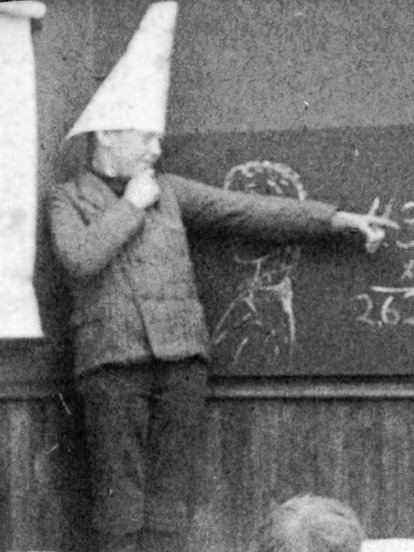 | ||
A dunce is a person considered incapable of learning. The word is derived from the name of the Scholastic theologian and philosopher John Duns Scotus, also referred to as Doctor Subtillis, or "Subtle Doctor", whose works on logic, theology and philosophy were accepted textbooks in the universities from the fourteenth century.
Contents
Duns or Dunsman was a name applied to the followers of John Duns Scotus, who were also called the Scotists. When in the sixteenth century the Scotists argued against Renaissance humanism, the term duns or dunce became, in the mouths of the Protestants, a term of abuse and a synonym for one incapable of scholarship. This was the etymology given by Richard Stinhurst. Samuel Johnson, on the other hand, maintained that the source of the word was unknown.
Dunces are often comedically shown wearing paper cone hats, known as dunce caps with the word "dunce" or "dumb", or simply a capitalized "D" on them. Schoolchildren were sometimes compelled to wear a dunce cap and to sit on a stool in the corner as a form of humiliating punishment for misbehaving or for failing to demonstrate that they had properly performed their studies.
Origins
The word "dunce" comes from John Duns Scotus (c. 1266–1308), the Scottish Franciscan scholar who, with Thomas Aquinas and William of Ockham, was one of the leading Scholastic philosopher-theologians of the High Middle Ages. Duns Scotus wrote treatises on theology, grammar, logic and metaphysics which were widely influential throughout Western Europe, earning Duns the papal accolade Doctor Subtilis (Subtle Teacher). (Duns remains highly esteemed in the Roman Catholic Church, and was beatified by Pope John Paul II in 1993.) However, with the advent of the Renaissance and the New Learning, and then the Protestant Reformation, many of Duns's theories and methods (which were considered hair-splitting) were challenged or rejected by Humanist and Protestant scholars, who used the term "Dunsman" or "Dunce" in a pejorative sense to denote those who foolishly clung on to outmoded doctrine. (The form "Dunce" reflects the medieval pronunciation of "Duns".) Gradually "dunsman" or "dunce" was used more widely for anyone stupid or dull-witted.
Dunce cap
A dunce cap, also variously known as a dunce hat, dunce's cap or dunce's hat, is a pointed hat, formerly used as an article of discipline in schools. In popular culture, it is typically made of paper and often marked with a D or the word "dunce", and given to unruly schoolchildren to wear. Frequently the 'dunce' was made to stand in the corner, facing the wall. The hope was that no one would want to be labelled the "dunce" in the class, even for a short period of time, and would thus avoid misbehaviour. Examples of behaviour which could warrant the dunce cap included throwing spitballs, passing notes, or pulling of hair. Class clowns were frequently admonished with the dunce cap.
In modern pedagogy, dunce caps are extremely rare.
According to The Straight Dope, Duns Scotus recommended the wearing of conical hats to stimulate the brain – so-called "thinking caps". (This notion is the likely source of the pointed hats traditionally worn by wizards, etc..) However, the Oxford English Dictionary (2nd edition) records that the term "dunce cap" itself did not enter the English language until after the term "dunce" had become a synonym for "fool" or "dimwit". In fact, "dunce cap" is not recorded before the 1840 novel The Old Curiosity Shop by Charles Dickens. John Ford's 1624 play The Sun's Darling is the first recorded mention of the related term "dunce table," a table provided for duller or poorer students.
Literary dunce
A literary dunce is a person, either real or fictional, who is used in literature as a target of satire. This usage of the term derives from Alexander Pope's landmark poetic satire The Dunciad, and the list is for figures used as dunces by eighteenth-century British satire (in the standard literary-historical sense of the "long" eighteenth century, 1660–1800).
It is also for early nineteenth-century authors who used the same general terminology (e.g., Lord Byron and Samuel Taylor Coleridge who knew and used Pope's category). Dunces are not villains, although they can be villainous, as much as they are held up as the epitome of stupidity, imposture, and connivance. Inclusion in the list below does not imply that the figure was a dullard. In fact, the opposite is likely true, as these figures needed to rise to a position of importance to be satirized in this way. Instead, these are figures who were satirized particularly as symbols of all things "wrong" with society or a particular political position. Unfortunately, in some cases it has overshadowed their merits.
